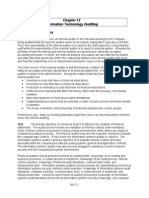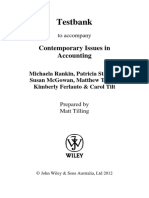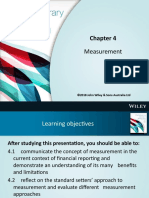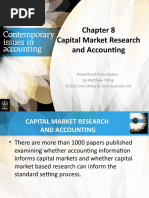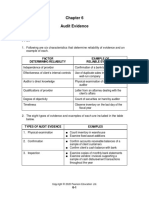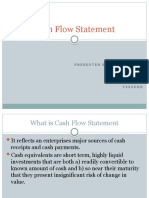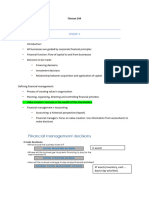Accounting Theory and Analysis Chart 16 Test Bank
Accounting Theory and Analysis Chart 16 Test Bank
Uploaded by
Sonny MaciasCopyright:
Available Formats
Accounting Theory and Analysis Chart 16 Test Bank
Accounting Theory and Analysis Chart 16 Test Bank
Uploaded by
Sonny MaciasOriginal Description:
Copyright
Available Formats
Share this document
Did you find this document useful?
Is this content inappropriate?
Copyright:
Available Formats
Accounting Theory and Analysis Chart 16 Test Bank
Accounting Theory and Analysis Chart 16 Test Bank
Uploaded by
Sonny MaciasCopyright:
Available Formats
Accounting Theory and Analysis
11th Edition
Test Bank
By
Richard G. Schroeder
University of North Carolina at Charlotte
Myrtle W. Clark
University of Kentucky
Jack M. Cathey
University of North Carolina at Charlotte
Accounting Theory & Analysis: Text and Cases
Test Bank, Chapter 16 Page 1
Chapter 16
Multiple Choice
1. Consolidated statements are proper for Neely, Inc., Randle, Inc., and Walker, Inc., if
a. Neely owns 80 percent of the outstanding common stock of Randle and 40 percent
of Walker; Randle owns 30 percent of Walker.
b. Neely owns 100 percent of the outstanding common stock of Randle and 90 percent
of Walker; Neely bought the stock of Walker one month before the balance sheet
date and sold it seven weeks later.
c. Neely owns 100 percent of the outstanding common stock of Randle and Walker;
Walker is in legal reorganization.
d. Neely owns 80 percent of the outstanding common stock of Randle and 40 percent
of Walker; Reeves, Inc., owns 55 percent of Walker.
Answer a
2. On October 1, Company X acquired for cash all of the outstanding common stock of
Company Y. Both companies have a December 31 year end and have been in business
for many years. Consolidated net income for the year ended December 31 should
include net income of
a. Company X for3 months and Company Y for 3 months
b. Company X for 12 months and Company Y for 3 months
c. Company X for 12 months and Company Y for 12 months
d. Company X for 12 months, but no income from Company Y until Company Y
distributed a dividend
Answer b
3. Arkin, Inc., owns 90 percent of the outstanding stock of Baldwin Company. Curtis, Inc.,
owns 10 percent of the outstanding stock of Baldwin Company. On the consolidated
financial statements of Arkin, Curtis should be considered as
a. A holding company
b. A subsidiary not to be consolidated
c. An affiliate
d. A noncontrolling interest
Answer d
4. A sale of goods, denominated in a currency other than the entity’s functional currency,
resulted in a receivable that was fixed in terms of the amount of foreign currency that
would be received. Exchange rates between the functional currency and the currency in
which the transaction was denominated changed. The resulting gain should be include
as a (an)
Accounting Theory & Analysis: Text and Cases
Test Bank, Chapter 16 Page 2
a. Other comprehensive income
b. Deferred credit
c. Component of income from continuing operations
d. Extraordinary item
Answer a
5. Which of the following is not a consideration in segment reporting for diversified
enterprises?
a. Allocation of joint costs
b. Transfer pricing
c. Defining the segments
d. Consolidation policy
Answer d
6. Which of the following is the appropriate basis for valuing fixed assets acquired in a
business combination carried out by exchanging cash for common stock?
a. Historic cost
b. Book value
c. Cost plus any excess of purchase price over book value of asset acquired
d. Fair value
Answer d
7. Goodwill represents the excess of the cost of an acquired company over the
a. Sum of the fair values assigned to identifiable assets acquired less liabilities
assumed
b. Sum of the fair values assigned to tangible assets acquired less liabilities assumed
c. Sum of the fair values assigned to intangible assets acquired less liabilities
assumed
d. Book value of an acquired company
Answer a
8. The theoretically preferred method of presenting noncontrolling interest on a
consolidated balance sheet is
a. As a separate item with the deferred credits section
b. As a reduction from (contra to) goodwill from consolidation, if any
c. By means of notes or footnotes to the balance sheet
d. As a separate item within the stockholders’ equity section
Answer d
Accounting Theory & Analysis: Text and Cases
Test Bank, Chapter 16 Page 3
9. Meredith Company and Kyle Company were combined in an acquisition transaction.
Meredith was able to acquire Kyle at a bargain price. The sum of the market or
appraised values of identifiable assets acquired less the fair value of liabilities assumed
exceeded the cost to Meredith. After revaluing noncurrent assets to zero there was still
some of the bargain purchase amount remaining (formerly termed negative goodwill).
Proper accounting treatment by Meredith is to report the amount as
a. An extraordinary item
b. Part of current income in the year of combination
c. A deferred credit and amortize it
d. Paid-in capital
Answer b
10. When translating foreign currency financial statements, which of the following accounts
would be translated using current exchange rates?
Property, Plant, and Inventories
Equipment carried at cost
a. Yes Yes
b. No No
c. Yes No
d. No Yes
Answer d
11. In financial reporting for segments of a business enterprise, the operating profit or loss of
a segment should include
Reasonably allocated
Common Traceable
Operating costs operating costs
a. No No
b. No Yes
c. Yes No
d. Yes Yes
Answer d
12. The profitability information that should be reported for each reportable segment of a
business enterprise consists of
a. An operating profit-or-loss figure consisting of segment revenues less traceable
costs and allocated common costs
b. An operating profit-or-loss figure consisting of segment revenues less traceable
costs but not allocated common costs
Accounting Theory & Analysis: Text and Cases
Test Bank, Chapter 16 Page 4
c. An operating profit-or-loss figure consisting of segment revenues less allocated
common costs but not traceable costs
d. Segment revenues only
Answer a
13. A foreign subsidiary’s function currency is its local currency that has not experienced
significant inflation. The weighted average exchange rate for the current year would be
the appropriate exchange rate for translating
Sales to
Wages expense Customers
a. Yes Yes
b. Yes No
c. No No
d. No Yes
Answer a
14. A subsidiary’s functional currency is the local currency that has not experienced
significant inflation. The appropriate exchange rate for translating the depreciation on
plant assets in the income statement of the foreign subsidiary is the
a. Exit exchange rate
b. Historical exchange rate
c. Weighted average exchange rate over the economic life of each plant asset
d. Weighted average exchange rate for the current year
Answer b
15. In a business combination that is accounted for under the acquisition method, the entity
that obtains control over one or more businesses and establishes the acquisition date
that control was achieved is called the
a. Controller.
b. Acquirer.
c. Proprietor.
d. Controlling interest.
Answer b
16. Under the acquisition method for a business combination, the cost incurred to effect the
business combination, such as finders and legal fees are
a. Considered part of the historical cost of the business.
b. Expensed as incurred.
c. Allocated, along with the purchase price of the acquired company’s stock to the
assets of the acquiree company.
Accounting Theory & Analysis: Text and Cases
Test Bank, Chapter 16 Page 5
d. Deferred until a full accounting of all costs to acquire the acquire company are
known.
Answer b
17. Under which of the theories of equity is a manager’s goals considered as important as
those of the common stockholder.
a. Proprietary theory.
b. Commander theory.
c. Entity theory.
d. Enterprise theory.
Answer c
18. For a business combination, we measure all assets and liabilities of an acquired
company at fair value. Fair value
a. Is an exit value.
b. Is an entry value.
c. Is an appraisal value.
d. Can be either an exit value or an entry value depending on the circumstances.
Answer a
19. Under the acquisition method of accounting for a business combination, restructuring
costs are
a. Capitalized and amortized over a period not exceeding ten years.
b. Fees paid to lawyers and accountants to bring about the business combination .
c. Costs incurred to effect the business combination.
d. Treated as post acquisition expenses.
Answer d
20. Under the acquisition method of accounting for a business combination, goodwill is
equal to
a. The acquired company’s ability to generate excess profits .
b. The excess of the cost of the acquisition plus the fair value of the noncontrolling
interest over the fair value of the acquiree’s net assets.
c. The excess of the cost of the acquisition over the fair value of the acquiree’s net
assets.
d. The excess of the fair value of acquiree’s net assets over the cost of acquisition.
Answer b
Accounting Theory & Analysis: Text and Cases
Test Bank, Chapter 16 Page 6
21. Under the acquisition method of accounting for a business combination, a bargain
purchase is
a. Reported as goodwill in the balance sheet.
b. Tested annually for impairment.
c. Reported as a gain in the income statement.
d. Reported as an adjustment to other comprehensive income.
Answer c
22. The acquisition method of accounting for a business combination is consistent with
a. Entity theory.
b. Proprietary theory.
c. Parent company theory.
a. Residual interest theory.
Answer a
23. Under the acquisition method of accounting for a business combination when the parent
company has acquired only 90% of the voting stock of a subsidiary,
a. 10% of the goodwill will be reported in a separate section of the balance sheet
because it belongs to the noncontrolling interest .
b. The consolidated balance sheet will report 100% of the value of goodwill.
c. The consolidated balance sheet will report 90% of the value of goodwill.
d. Goodwill will be amortized over its useful life or 40 years whichever comes first.
Answer b
24. The noncontrolling interest in a subsidiary is reported in the consolidated balance
sheet
a. As an investment.
b. As a liability.
c. At fair value, as determined on the acquisition date.
d. As an element of stockholders’ equity.
Answer d
Essay
1. List and explain three reasons why businesses combine.
Several factors may cause a business organization to consider combining with another
organization:
Tax consequences. —The purchasing corporation may accrue the benefits of
operating loss carryforwards from acquired corporations.
Accounting Theory & Analysis: Text and Cases
Test Bank, Chapter 16 Page 7
Growth and diversification. —The purchasing corporation may wish to acquire a new
product or enter a new market.
Financial considerations. —A larger asset base may make it easier for the
corporation to acquire additional funds from capital markets.
Competitive pressure. —Economies of scale may alleviate a highly competitive
market situation.
Profit and retirement. —The seller may be motivated by a high profit or the desire to
retire.
2. Discuss the issues that are to be addressed in an acquisition method business
combination effected by an exchange of equity shares.
When a business combination is effected by an exchange of equity shares, the acquiring
entity may not be so clearly evident. In this case, FASB ASC 805-10-55-12 requires that
the following “pertinent facts and circumstances” be taken into consideration:
1. The relative voting rights of the combined entity. All else being equal, the acquiring
entity would be the one whose owners retained or received the larger portion of the
voting rights of the combined entity.
2. The existence of a large minority voting interest in the combined entity when no other
owner or group of owners has a significant voting interest. All else being equal, the
acquiring entity would be the one with the large minority voting interest.
3. The composition of the governing body of the combined entity. All else being equal,
the acquiring entity’s owners or governing body would be the one that has the ability
to elect or appoint a majority of the governing body of the combined entity.
4. The composition of senior management of the combined entity. All else being equal,
the acquiring entity’s senior management would dominate that of the combined
entity.
The terms of exchange of equity securities. All else being equal, the acquiring entity
would be the one that pays a premium over the market value of the equity securities
of the other combining entities.
3. How is the recorded cost determined in an acquisition business combination?
Under the revised standard for business combinations, the acquirer must recognize all
assets acquired, liabilities assumed and any noncontrolling interest at fair value,
measured as of the acquisition date (the date that control is attained). Fair value is
defined by the FASB ASC (820-10-20) as an exit value. It is the exchange price that
would occur in an orderly transaction to sell an asset or transfer a liability in the most
advantageous market. Thus, fair value is market based and is not entity specific. Fair
value excludes transaction costs because they are the incremental direct costs incurred
to sell an asset or settle a debt. As such, they are specific to the transaction, and have
nothing to do with the value of the asset acquired itself or the liability assumed.
Fair value must be applied to assets and liabilities that meet the definition of assets and
liabilities under SFAC No. 6. This means that the acquirer must recognize all assets and
liabilities of the acquiree – even those that are not on the acquiree’s books. Thus, the
acquirer must identify and measure intangibles such as brand names and even in-
Accounting Theory & Analysis: Text and Cases
Test Bank, Chapter 16 Page 8
process research and development as well as advertising jingles. In order to recognize
such an intangible asset it must meet either of the two following criteria: (1) separability
or (2) contractual or legal. Separability means that the intangible can be sold,
transferred, licensed, rented or exchanged. The contractual/legal criterion is that the
asset arises from some contractual or legal right.
4. What are the two principles that are used to guide the preparation of consolidated
financial statements?
.In the preparation of consolidated financial statements, two overriding principles prevail.
The first is balance sheet oriented and the second is income statement oriented.
1. The entity cannot own or owe itself.
2. The entity cannot make a profit by selling to itself.
5. Explain the concept of control as it applies to recording consolidated financial statement.
Control is defined as “the power of one entity to direct or cause the direction of the
management and operating and financing policies of another entity.” Control is normally
presumed when the parent owns, either directly or indirectly, a majority of the voting
stock of the subsidiary. The following exceptions indicating an inability to control a
majority-owned subsidiary are cited in FASB ASC 810-10-15-10:
1. The subsidiary is in a legal reorganization or bankruptcy.
2. There are severe governmentally imposed uncertainties.
In some cases control may exit with less than a majority ownership, for example, by
contract, by lease, as the result of an agreement with stockholders, or by court decree
6. Discuss the following two theories of consolidation:
a. Entity
According to entity theory, the consolidated group (parent company and subsidiaries) is
an entity separate from its owners. Thus, the emphasis is on control of the group of legal
entities operating as a single unit. Consolidated assets belong to the consolidated entity,
and the income earned by investing in those assets is income to the consolidated entity
rather than to the parent company stockholders. Consequently, the purpose of
consolidated statements is to provide information to all shareholders—parent company
stockholders and outside noncontrolling stockholders of the subsidiaries.
b. Patent company
Parent company theory evolved from the proprietary theory of equity. Under parent
company theory, parent company stockholders are viewed as having a proprietary
interest in the net assets of the consolidated group. The purpose of consolidated
statements is to provide information primarily for parent company stockholders. Thus,
prior to the issuance of SFAS No. 160, consolidated financial statements reflected a
parent company perspective. The assets reported on a consolidated balance sheet were
those of the subsidiary adjusted by the parent company’s share of the difference
between subsidiary historical cost and the asset’s fair value at the date of the
acquisition. The net income reported in the consolidated income statement was equal to
Accounting Theory & Analysis: Text and Cases
Test Bank, Chapter 16 Page 9
the net income of the parent company. Noncontrolling interest income was reported as
a deduction to arrive at consolidated net income and noncontrolling interest was not
considered an equity interest.
7. Define noncontrolling interest. Historically, how has noncontrolling interest been
disclosed on corporate balance sheets
When a portion of a subsidiary’s stock is owned by investors outside the parent
company, this ownership interest is referred to as noncontrolling interest or previously
termed minority interest in financial statements. . In prior practice, noncontrolling interest
has been variously (1) disclosed as a liability, (2) separately presented between liabilities
and stockholders’ equity, and (3) disclosed as a part of stockholders’ equity.
8. According to SFAS No. 131(FASB ASC 280-10-50-20 to 25), what information should be
disclosed for each operating segment?
Under the provisions of SFAS No. 131 (See FASB ASC 280-10-50-20 to 25), companies
are required to report separately income statement and balance sheet information about
each operating segment. In addition to a measure of a segment’s profit or loss and total
assets, companies are to report specific information if it is included in the measure of
segment profit or loss by the chief operating decision maker. The list of such segment
disclosures is as follows:
1. Revenues from external users
2. Revenues from transactions with other operating segments of the same enterprise
3. Interest revenue
4. Interest expense
5. Depreciation, depletion, and amortization expense
6. Unusual items
7. Equity in the net income of investees under the equity method
8. Income tax expense or benefit
9. Extraordinary items
10. Significant noncash items other than depreciation, depletion, and amortization
expense
9. How are operating segments defined by SFAS No. 131 (FASB ASC 280-10-50-1)?
A goal of the guidance contained at FASB ASC 280 is to use the enterprise’s internal
organization in such a way that reportable operating segments will be readily evident to
the financial statement preparer. The resulting “management approach” to identifying
operating segments is based on the manner in which management organizes the
segments for making operating decisions and assessing performance.
FASB ASC 280-10-50-1 defines an operating segment as a component of the
enterprise
That engages in business activities from which it may earn revenues and incur
expenses.
Whose operating results are regularly reviewed by the chief operating decision
maker of the enterprise in making decisions about allocating resources to the
segment and in assessing segment performance.
Accounting Theory & Analysis: Text and Cases
Test Bank, Chapter 16 Page 10
For which discrete financial information is available.
10. Discuss the criteria used to determine if an operating segment is a reportable segment.
Reportable segments include those operating segments that meet any of the following
quantitative thresholds:
1. Reported revenue is at least 10 percent of combined revenue.
2. Reported profit (loss) is at least 10 percent of combined profit (loss).
3. Assets are 10 percent or more of combined assets.
11. Discuss how foreign currency translation occurs under each of the following methods
a. Current – noncurrent
The current–noncurrent method is based on the distinction between current and
noncurrent assets and liabilities. Under this method all current items (cash, receivables,
inventory, and short-term liabilities) are translated at the foreign exchange rate existing
at the balance sheet date. The noncurrent items (plant, equipment, property, and long-
term liabilities) are translated using the rate in effect when the items were acquired or
incurred (the historical rate).
b. Monetary – nonmonetary
The monetary–nonmonetary method requires that a distinction be made between
monetary items (accounts representing cash or claims on cash, such as receivables,
notes payable, and bonds payable) and nonmonetary items (accounts not representing
claims on a specific amount of cash such as land, inventory, plant, equipment, and
capital stock). Monetary items are translated at the exchange rate in effect at the
balance sheet date, whereas nonmonetary items retain the historical exchange rate.
c. Current
The current rate method requires the translation of all assets and liabilities at the
exchange rate in effect on the balance sheet date (current rate). It is, therefore, the only
method that translates fixed assets at current rather than historical rates.
d. Temporal
Under this method monetary measurements depend on the temporal characteristics of
assets and liabilities. That is, the time of measurement of the elements depends on
certain characteristics. That is, money and receivables and payables measured at the
amounts promised should be translated at the foreign exchange rate in effect at the
balance sheet date. Assets and liabilities measured at money prices should be
translated at the foreign exchange rate in effect at the dates to which the money prices
pertain. This principle is simply an application of the fair value principle in the area of
foreign translation.
Accounting Theory & Analysis: Text and Cases
Test Bank, Chapter 16 Page 11
12. How does SFAS No. 52 (FASB ASC 830) define functional currency?
FASB ASC 830 adopts the functional currency approach to translation. An entity’s
functional currency is defined as the currency of the primary economic environment in
which it operates, which will normally be the environment in which it expends cash (See
FASB ASC 830-30).
13. What are the two situations in which the local currency would not be the functional
currency?
The two situations in which the local currency would not be the functional currency are:
1. The foreign country’s economic environment is highly inflationary (over 100 percent
cumulative inflation
2. The company’s investment is not considered long term.
14. Discuss the difference between translation and remeasurement.
Translation is the process of expressing in the reporting currency of the enterprise those
amounts that are denominated or measured in a different currency. The translation
process is performed in order to prepare financial statements and assumes that the
foreign subsidiary is freestanding and that the foreign accounts will not be liquidated into
U.S. dollars. Therefore, translation adjustments are disclosed as a part of other
comprehensive income rather than as adjustments to net income.
Remeasurement is the process of measuring transactions originally denominated in a
different unit of currency (e.g., purchases of an English subsidiary of a U.S. company
payable in French euros). Remeasurement is required when:
1. A foreign entity operates in a highly inflationary economy.
2. The accounts of an entity are maintained in a currency other than its functional
currency.
3. A foreign entity is a party to a transaction that produces a monetary asset or liability
denominated in a currency other than its functional currency.
15. Describe the four general procedures involved in the foreign currency translation
process when the local currency is defined as the functional currency.
Most frequently the functional currency will be the local currency, and four general
procedures are involved in the translation process when the local currency is defined as
the functional currency:
1. The financial statements of each individual foreign entity are initially recorded in that
entity’s functional currency. For example, a Japanese subsidiary would initially
prepare its financial statements in terms of yen, for that would be the currency it
generally uses to carry out cash transactions.
2. The foreign entity’s statements must be adjusted (if necessary) to comply with
generally accepted accounting principles in the United States.
3. The financial statements of the foreign entity are translated into the reporting
currency of the parent company (usually the U.S. dollar). Assets and liabilities are
Accounting Theory & Analysis: Text and Cases
Test Bank, Chapter 16 Page 12
translated at the current exchange rate at the balance sheet date. Revenues,
expenses, gains, and losses are translated at the rate in effect at the date they were
first recognized, or alternatively, at the average rate for the period.
4. Translation gains and losses are accumulated and reported as a component of other
comprehensive income.
16. IFRS No. 10 changes the method of reporting noncontrolling interests from what was
previously required in IAS No.27. How are noncontrolling interest now defined and
where are they to be disclosed?
Noncontrolling interests are now defined as”noncontrolling interests,” rather than as
minority interests. They are to be disclosed in the consolidated balance sheet within
equity, but separate from the parent's shareholders' equity.
Accounting Theory & Analysis: Text and Cases
Test Bank, Chapter 16 Page 13
Accounting Theory & Analysis: Text and Cases
Test Bank, Chapter 16 Page 14
You might also like
- (Ebook PDF) Financial Accounting Theory and Analysis: Text and Cases 13th Edition All Chapters Instant Download100% (3)(Ebook PDF) Financial Accounting Theory and Analysis: Text and Cases 13th Edition All Chapters Instant Download51 pages
- Standard Setting: ©2018 John Wiley & Sons Australia LTDNo ratings yetStandard Setting: ©2018 John Wiley & Sons Australia LTD41 pages
- Financial Statement Analysis: K.R. SubramanyamNo ratings yetFinancial Statement Analysis: K.R. Subramanyam49 pages
- Financial Statement Analysis - 10e by K. R. Am & John J. Wild Chapter02No ratings yetFinancial Statement Analysis - 10e by K. R. Am & John J. Wild Chapter0240 pages
- Reminder: Use Your Official Answer Sheet: Universidad de ManilaNo ratings yetReminder: Use Your Official Answer Sheet: Universidad de Manila25 pages
- Financial Accounting: Theory and Analysis: Text and Cases 12 EditionNo ratings yetFinancial Accounting: Theory and Analysis: Text and Cases 12 Edition43 pages
- Accounting Theory (AcT) (Teori Akuntansi (TA) ) - Chapter 9 (Godfrey) - PPT-revenue (14 A)No ratings yetAccounting Theory (AcT) (Teori Akuntansi (TA) ) - Chapter 9 (Godfrey) - PPT-revenue (14 A)24 pages
- Accounting Theory and Analysis: 11 EditionNo ratings yetAccounting Theory and Analysis: 11 Edition21 pages
- Conceptual Framework Dalam Pelaporan KeuanganNo ratings yetConceptual Framework Dalam Pelaporan Keuangan63 pages
- MAKSI-Pemodelan Dan Visualisasi Data Gasal 2122No ratings yetMAKSI-Pemodelan Dan Visualisasi Data Gasal 21225 pages
- Measurement: ©2018 John Wiley & Sons Australia LTDNo ratings yetMeasurement: ©2018 John Wiley & Sons Australia LTD50 pages
- Capital Market Research and Accounting: Powerpoint Presentation by Matthew Tilling ©2012 John Wiley & Sons Australia LTD100% (1)Capital Market Research and Accounting: Powerpoint Presentation by Matthew Tilling ©2012 John Wiley & Sons Australia LTD35 pages
- Romney Ais14 CH 16 General Ledger and Reporting SystemNo ratings yetRomney Ais14 CH 16 General Ledger and Reporting System11 pages
- Texas Industries Vs Hewlett-Packard Case 13.3No ratings yetTexas Industries Vs Hewlett-Packard Case 13.310 pages
- Foreword: Financial Auditing 1 - 9 Edition - 1No ratings yetForeword: Financial Auditing 1 - 9 Edition - 137 pages
- Multinational Accounting: Issues in Financial Reporting and Translation of Foreign Entity StatementsNo ratings yetMultinational Accounting: Issues in Financial Reporting and Translation of Foreign Entity Statements53 pages
- Measurement Theory and Accounting Measurement System (Part II) - 26 Mar 2015 - GSLCCCCCCCCNo ratings yetMeasurement Theory and Accounting Measurement System (Part II) - 26 Mar 2015 - GSLCCCCCCCC37 pages
- Corporate Governance 5e Christine A. Mallin: Shareholders and StakeholdersNo ratings yetCorporate Governance 5e Christine A. Mallin: Shareholders and Stakeholders9 pages
- Financial Statement Analysis: K R Subramanyam John J WildNo ratings yetFinancial Statement Analysis: K R Subramanyam John J Wild40 pages
- Chapter 7 Analisis Laporan Keuangan Subramanyam100% (1)Chapter 7 Analisis Laporan Keuangan Subramanyam59 pages
- Income Flows Versus Cash Flows: Understanding The Statement of Cash FlowsNo ratings yetIncome Flows Versus Cash Flows: Understanding The Statement of Cash Flows26 pages
- Solution CH 5 Audit Evidence and DocumentationNo ratings yetSolution CH 5 Audit Evidence and Documentation28 pages
- 8 TA Normative - The Case of Conceptual Framework ProjectsNo ratings yet8 TA Normative - The Case of Conceptual Framework Projects57 pages
- IPSAS Explained: A Summary of International Public Sector Accounting StandardsFrom EverandIPSAS Explained: A Summary of International Public Sector Accounting StandardsNo ratings yet
- Financial Accounting Theory and Analysis Text and Cases 11th Edition Schroeder Test Bank100% (26)Financial Accounting Theory and Analysis Text and Cases 11th Edition Schroeder Test Bank12 pages
- Financial Analysis: Learning ObjectivesNo ratings yetFinancial Analysis: Learning Objectives39 pages
- Investments: Background and Issues: Bodie, Kane, and Marcus Eleventh EditionNo ratings yetInvestments: Background and Issues: Bodie, Kane, and Marcus Eleventh Edition39 pages
- Nba Advanced - Happy Hour Co - DCF Model v2No ratings yetNba Advanced - Happy Hour Co - DCF Model v210 pages
- Accounting For Government and Not-For-Profit OrganizationsNo ratings yetAccounting For Government and Not-For-Profit Organizations8 pages
- Cash Flow Statement: Presented By: Monojit Roy Punit Baiya Shasank Smita Sachhan VigneshNo ratings yetCash Flow Statement: Presented By: Monojit Roy Punit Baiya Shasank Smita Sachhan Vignesh13 pages
- Consolidated Statements After Acquisition: 2238 Financial Reporting - 2021/2022 T1No ratings yetConsolidated Statements After Acquisition: 2238 Financial Reporting - 2021/2022 T120 pages
- Cash Flow Statement Activity Wise 05-02-24No ratings yetCash Flow Statement Activity Wise 05-02-247 pages
- Solution Manual: (Updated Through November 11, 2013)No ratings yetSolution Manual: (Updated Through November 11, 2013)55 pages
- Reverse Mortgage Line of Credit Growth RateNo ratings yetReverse Mortgage Line of Credit Growth Rate2 pages
- Property, Plant, Equipment: Abbey Corporation Statement of Financial Position DECEMBER 31,2015 AssetNo ratings yetProperty, Plant, Equipment: Abbey Corporation Statement of Financial Position DECEMBER 31,2015 Asset4 pages
- Dhruv Granites: (Mukesh Surana) Membership No. 077745No ratings yetDhruv Granites: (Mukesh Surana) Membership No. 0777454 pages
- (Ebook PDF) Financial Accounting Theory and Analysis: Text and Cases 13th Edition All Chapters Instant Download(Ebook PDF) Financial Accounting Theory and Analysis: Text and Cases 13th Edition All Chapters Instant Download
- Standard Setting: ©2018 John Wiley & Sons Australia LTDStandard Setting: ©2018 John Wiley & Sons Australia LTD
- Financial Statement Analysis - 10e by K. R. Am & John J. Wild Chapter02Financial Statement Analysis - 10e by K. R. Am & John J. Wild Chapter02
- Reminder: Use Your Official Answer Sheet: Universidad de ManilaReminder: Use Your Official Answer Sheet: Universidad de Manila
- Financial Accounting: Theory and Analysis: Text and Cases 12 EditionFinancial Accounting: Theory and Analysis: Text and Cases 12 Edition
- Accounting Theory (AcT) (Teori Akuntansi (TA) ) - Chapter 9 (Godfrey) - PPT-revenue (14 A)Accounting Theory (AcT) (Teori Akuntansi (TA) ) - Chapter 9 (Godfrey) - PPT-revenue (14 A)
- Measurement: ©2018 John Wiley & Sons Australia LTDMeasurement: ©2018 John Wiley & Sons Australia LTD
- Capital Market Research and Accounting: Powerpoint Presentation by Matthew Tilling ©2012 John Wiley & Sons Australia LTDCapital Market Research and Accounting: Powerpoint Presentation by Matthew Tilling ©2012 John Wiley & Sons Australia LTD
- Romney Ais14 CH 16 General Ledger and Reporting SystemRomney Ais14 CH 16 General Ledger and Reporting System
- Multinational Accounting: Issues in Financial Reporting and Translation of Foreign Entity StatementsMultinational Accounting: Issues in Financial Reporting and Translation of Foreign Entity Statements
- Measurement Theory and Accounting Measurement System (Part II) - 26 Mar 2015 - GSLCCCCCCCCMeasurement Theory and Accounting Measurement System (Part II) - 26 Mar 2015 - GSLCCCCCCCC
- Corporate Governance 5e Christine A. Mallin: Shareholders and StakeholdersCorporate Governance 5e Christine A. Mallin: Shareholders and Stakeholders
- Financial Statement Analysis: K R Subramanyam John J WildFinancial Statement Analysis: K R Subramanyam John J Wild
- Income Flows Versus Cash Flows: Understanding The Statement of Cash FlowsIncome Flows Versus Cash Flows: Understanding The Statement of Cash Flows
- 8 TA Normative - The Case of Conceptual Framework Projects8 TA Normative - The Case of Conceptual Framework Projects
- IPSAS Explained: A Summary of International Public Sector Accounting StandardsFrom EverandIPSAS Explained: A Summary of International Public Sector Accounting Standards
- Financial Accounting Theory and Analysis Text and Cases 11th Edition Schroeder Test BankFinancial Accounting Theory and Analysis Text and Cases 11th Edition Schroeder Test Bank
- Investments: Background and Issues: Bodie, Kane, and Marcus Eleventh EditionInvestments: Background and Issues: Bodie, Kane, and Marcus Eleventh Edition
- Accounting For Government and Not-For-Profit OrganizationsAccounting For Government and Not-For-Profit Organizations
- Cash Flow Statement: Presented By: Monojit Roy Punit Baiya Shasank Smita Sachhan VigneshCash Flow Statement: Presented By: Monojit Roy Punit Baiya Shasank Smita Sachhan Vignesh
- Consolidated Statements After Acquisition: 2238 Financial Reporting - 2021/2022 T1Consolidated Statements After Acquisition: 2238 Financial Reporting - 2021/2022 T1
- Solution Manual: (Updated Through November 11, 2013)Solution Manual: (Updated Through November 11, 2013)
- Property, Plant, Equipment: Abbey Corporation Statement of Financial Position DECEMBER 31,2015 AssetProperty, Plant, Equipment: Abbey Corporation Statement of Financial Position DECEMBER 31,2015 Asset
- Dhruv Granites: (Mukesh Surana) Membership No. 077745Dhruv Granites: (Mukesh Surana) Membership No. 077745


